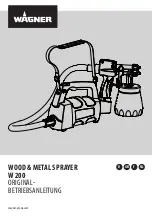
•
Operate only in daylight or good artificial light.
•
Never spray with bystanders present.
•
Never spray while people, especially children or
pets are nearby.
•
Before operating the machine, always check the
designated areas of the sprayer that are stated in
the Pre-Starting Checks in the Operation section.
If the machine does not function correctly or is
damaged in any way, do not use the sprayer.
Make sure that the problem is corrected before the
sprayer or attachment is operated.
•
Make sure that the operator’s area is clean and
free from chemical residue and debris buildup.
•
Ensure that all fluid line connectors are tight and
all hoses are in good condition before applying
pressure to the system.
Chemical Safety
WARNING
•
Chemical substances used in the sprayer
system may be hazardous and toxic to
you, bystanders, animals, plants, soils or
other property.
•
Carefully read and follow the chemical
warning labels and material safety data
sheets (MSDS) for all chemicals used and
protect yourself according to the chemical
manufacturer's recommendations. Ensure
that as little skin as possible is exposed
while using chemicals. Use appropriate
personal protective equipment (PPE)
to guard against personal contact with
chemicals, such as:
– safety glasses, goggles, and/or face
shield
– respirator or filter mask
– chemical resistant gloves
– rubber boots or other substantial
footwear
– hearing protection
– clean change of clothes, soap, and
disposable towels, to be kept on hand,
in the event of a chemical spill.
Important:
Keep in mind that there may be more
than 1 chemical used, and information on each
chemical should be assessed.
Refuse to operate or work on the sprayer if this
information is not available.
Before working on a sprayer system, make
sure that the system has been triple rinsed and
neutralized according to the recommendations of
the chemical manufacturer(s) and all of the valves
have been cycled 3 times.
Verify there is an adequate supply of clean water
and soap nearby, and immediately wash off any
chemicals that contact you.
•
Obtain proper training before using or handling
chemicals.
•
Use the correct chemical for the job.
•
Follow the chemical manufacturer's instructions for
the safe application of the chemical. Do not exceed
recommended system application pressure.
•
Do not fill, calibrate, or clean the unit when people,
especially children, or pets are in the area.
•
Handle chemicals in a well ventilated area.
•
Have clean water available especially when filling
the spray tank.
•
Do not eat, drink, or smoke while working with
chemicals.
•
Do not clean spray nozzles by blowing through
them or placing in your mouth.
•
Always wash your hands and other exposed areas
as soon as possible after you finish working with
chemicals.
•
Keep chemicals in their original packages and
stored in a safe location.
•
Properly dispose of unused chemicals and
chemical containers as instructed by the chemical
manufacturer and your local codes.
•
Chemicals and fumes are dangerous; never enter
the tank or place your head over or in the opening
of a tank.
•
Follow all local, state, and federal regulations for
spreading or spraying chemicals.
While Operating
WARNING
Engine exhaust contains carbon monoxide,
which is an odorless, deadly poison that can
kill you.
Do not run engine indoors or in an enclosed
area.
•
Remain seated whenever the sprayer is in motion.
Keep both hands on the steering wheel whenever
possible. Keep your arms and legs within the
operator’s compartment at all times.
5
Содержание Multi Pro 1750
Страница 17: ...g033286 Figure 6 1 Right section 4 Fresh water tank 2 Boom transport cradle 5 Operator s seat 3 Left section 17...
Страница 72: ...Schematics g028078 Sprayer System Schematic Rev DWG 125 0698 Rev B 72...
Страница 73: ...Notes...
Страница 74: ...Notes...






































